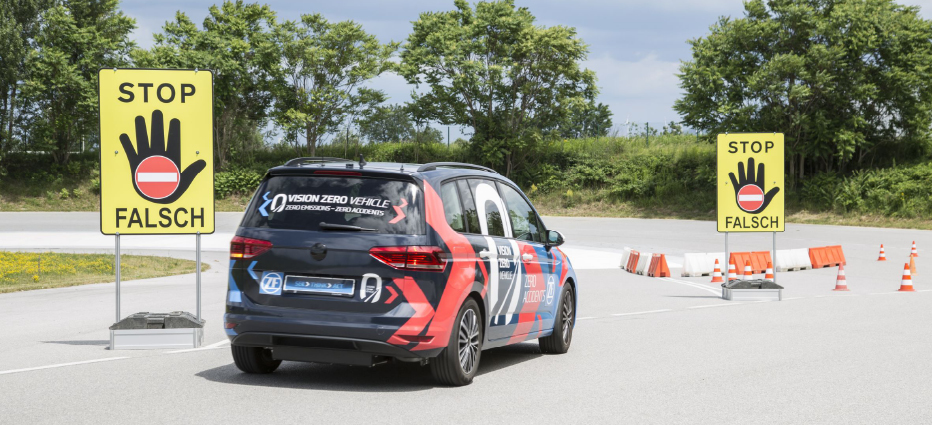
With its “Vision Zero Vehicle,” ZF has made great strides toward mobility without emissions or accidents.
The concept vehicle features intelligent mechanical systems capable of helping to prevent many accidents. “Driver Distraction Assist” has the capability to recognize driver distraction – today the number-two cause of accidents after excess speed – and if necessary help steer the vehicle safely until the danger is over. “Wrong-way Inhibit” is a ZF solution with the potential to help actively prevent wrong-way driving and its frequently fatal consequences. Such safety innovations are trailblazers in the transition from assisted to autonomous driving. The Vision Zero Vehicle represents not only a significant step toward future accident-free mobility but, thanks to its highly integrated electric axle drive, it also generates no local pollution.
“With our all-electric Vision Zero Vehicle and its innovative safety systems, we’ve achieved key advances that point to the future. Especially for the transition from assisted to autonomous driving, we strive for advanced and integrated safety systems to help keep drivers and passengers safe.” says ZF CEO Dr. Stefan Sommer. Wrong-way Inhibit and Driver Distraction Assist enable the vehicle itself to actively assist in correcting causes of serious accidents. These systems also highlight a central ZF competency: intelligent and networked mechanical systems that enable vehicles to see, think and act.
Keeps an eye on the driver
Research indicates that distracted driving continues to be an issue on the road. According to a road safety study by Allianz Zentrum für Technik, around one in 10 road fatalities today is due to distraction. In 2016, distraction caused the loss of 350 lives in Germany – 94 more than drunk driving. Figures from the U.S. reveal that in 2015 alone, wandering attention caused 3,477 deaths. A study by the Virginia Tech Transportation Institute carried out the previous year found that people behind the wheel are distracted more than half of the time (52 percent). They spend more than 6.4 percent of the time using their cell phones, with texting increasing the risk of accidents by a factor of 10.
“Driver Distraction Assist can help recognize lack of attention, warn the driver and, if necessary, take control until a potential danger has passed,” explains Dr. Harald Naunheimer, head of Research and Development at ZF.
The technology uses a laser-based time-of-flight interior camera with learning capability. The camera monitors the position of the driver’s head in 3D. Unlike digital video systems, it can be effective even in poor lighting. The system is designed to immediately register when the driver looks away from the road. In case of danger, it alerts the driver with an optical warning on the central display, an acoustic signal and active tightening of the seat belt. Simultaneously, the assistant is capable of taking over steering, also staying on track in curves. If the driver still does not react – the system can steadily reduce the drive torque. Finally, if the driver continues to ignore all warnings, the assistant can cut the throttle response and attempt to stop the car in a safe spot.
Actively prevents wrong-way driving
The ZF innovation Wrong-way Inhibit is above all designed to actively safeguard against driving the wrong way, which can have grave consequences. The U.S. National Transportation Safety Board reports that an average of 360 people are victims of wrong-way drivers annually on U.S. highways (in a study from 2004-2009). In Germany the total number of fatalities in 2016 was 12 – with 2,200 radio traffic announcements of wrong way incidents (according to the German Automobile Club ADAC). “With Wrong-way Inhibit we want to help put an end to tragic accidents caused by wrong-way driving,” says Naunheimer.
The system reacts as soon as there is an indication that the driver is about to enter a road in the wrong direction – whether due to distraction, poor visibility or disorientation. For example, if the driver heads for a freeway exit instead of an entry road, the system can first warn with an acoustic signal, seatbelt vibration and an optical signal on the dashboard display. Additionally, a significantly higher steering wheel resistance reinforces the message to the driver that he is about to make a wrong turn. If the driver still attempts to go in the wrong direction, the system can keep the car on the outside edge of the lane, brake initially to walking speed and then to a stop. Furthermore, the high beam headlights and the hazard warning lights can activate to warn oncoming traffic. The system only allows the driver to drive out of the danger zone along the edge of the road if there is space or if he shifts into reverse.
The Vision Zero Vehicle uses multiple approaches to help detect which road and which direction is right or wrong: by high-accuracy maps that are constantly updated via the cloud as well as traffic signs and road markings that are recognized and interpreted using a front camera system.
Zero local emissions
ZF’s Vision Zero Vehicle is helping to set the course for an accident-free and zero local emissions future. The vehicle features a 150 kW electric axle drive system for dynamic accelerative force. The compact drive unit houses not only the electric motor but also a two-stage one-speed spur gear drive, a differential and power electronics. It is housed in an innovative, space-saving modular ZF rear axle system called mSTARS (modular Semi-Trailing Arm Rear Suspension). The modular axle system makes it easier to electrify volume production vehicle platforms – even existing ones as demonstrated in the Vision Zero Vehicle. With mSTARS, ZF provides manufacturers with a basis for a wide range of applications in multiple vehicle segments. The solution is suitable for hybrid, fuel-cell and battery-powered vehicles as well as for combination with conventional all-wheel modules or the Active Kinematics Control active rear axle steering.
www.zf.com